weight FIAT IDEA 2012 1.G Owners Manual
[x] Cancel search | Manufacturer: FIAT, Model Year: 2012, Model line: IDEA, Model: FIAT IDEA 2012 1.GPages: 210, PDF Size: 3.65 MB
Page 77 of 210
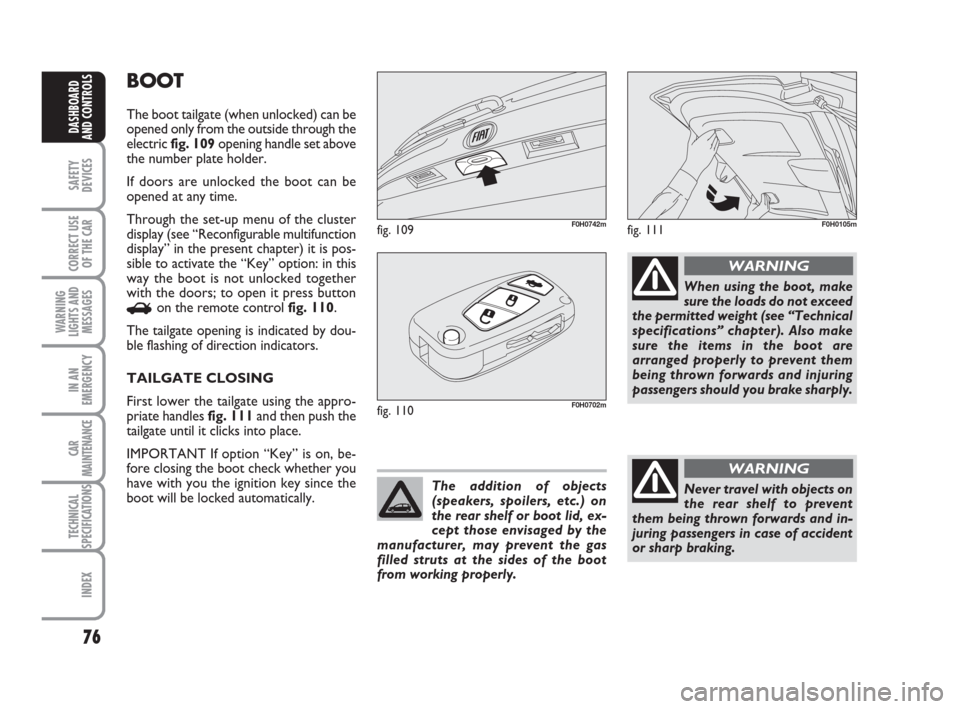
76
SAFETY
DEVICES
CORRECT USE
OF THE CAR
WARNING
LIGHTS AND
MESSAGES
IN AN
EMERGENCY
CAR
MAINTENANCE
TECHNICAL
SPECIFICATIONS
INDEX
DASHBOARD
AND CONTROLS
BOOT
The boot tailgate (when unlocked) can be
opened only from the outside through the
electric fig. 109opening handle set above
the number plate holder.
If doors are unlocked the boot can be
opened at any time.
Through the set-up menu of the cluster
display (see “Reconfigurable multifunction
display” in the present chapter) it is pos-
sible to activate the “Key” option: in this
way the boot is not unlocked together
with the doors; to open it press button
Ron the remote control fig. 110.
The tailgate opening is indicated by dou-
ble flashing of direction indicators.
TAILGATE CLOSING
First lower the tailgate using the appro-
priate handles fig. 111and then push the
tailgate until it clicks into place.
IMPORTANT If option “Key” is on, be-
fore closing the boot check whether you
have with you the ignition key since the
boot will be locked automatically.
fig. 109F0H0742m
fig. 110F0H0702m
The addition of objects
(speakers, spoilers, etc.) on
the rear shelf or boot lid, ex-
cept those envisaged by the
manufacturer, may prevent the gas
filled struts at the sides of the boot
from working properly.
When using the boot, make
sure the loads do not exceed
the permitted weight (see “Technical
specifications” chapter). Also make
sure the items in the boot are
arranged properly to prevent them
being thrown forwards and injuring
passengers should you brake sharply.
WARNING
Never travel with objects on
the rear shelf to prevent
them being thrown forwards and in-
juring passengers in case of accident
or sharp braking.
WARNING
fig. 111F0H0105m
036-092 idea GB 1 ed 10-07-2008 16:12 Pagina 76
Page 80 of 210
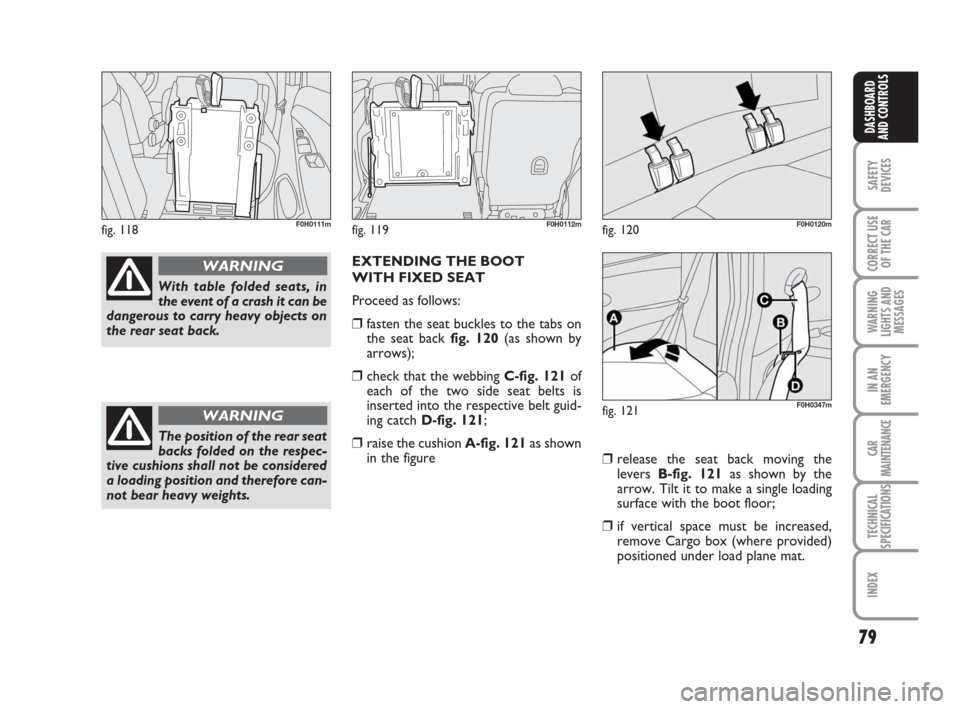
79
SAFETY
DEVICES
CORRECT USE
OF THE CAR
WARNING
LIGHTS AND
MESSAGES
IN AN
EMERGENCY
CAR
MAINTENANCE
TECHNICAL
SPECIFICATIONS
INDEX
DASHBOARD
AND CONTROLS
With table folded seats, in
the event of a crash it can be
dangerous to carry heavy objects on
the rear seat back.
WARNING
The position of the rear seat
backs folded on the respec-
tive cushions shall not be considered
a loading position and therefore can-
not bear heavy weights.
WARNING
fig. 118F0H0111mfig. 119F0H0112m
EXTENDING THE BOOT
WITH FIXED SEAT
Proceed as follows:
❒fasten the seat buckles to the tabs on
the seat back fig. 120(as shown by
arrows);
❒check that the webbing C-fig. 121of
each of the two side seat belts is
inserted into the respective belt guid-
ing catch D-fig. 121;
❒raise the cushion A-fig. 121as shown
in the figure
fig. 120F0H0120m
fig. 121F0H0347m
❒release the seat back moving the
levers B-fig. 121as shown by the
arrow. Tilt it to make a single loading
surface with the boot floor;
❒if vertical space must be increased,
remove Cargo box (where provided)
positioned under load plane mat.
036-092 idea GB 1 ed 10-07-2008 16:12 Pagina 79
Page 100 of 210

99
CORRECT USE
OF THE CAR
WARNING
LIGHTS AND
MESSAGES
IN AN
EMERGENCY
CAR
MAINTENANCE
TECHNICAL
SPECIFICATIONS
INDEX
DASHBOARD
AND CONTROLS
SAFETY
DEVICES
HOW TO KEEP
THE SEAT BELTS ALWAYS
IN EFFICIENT CONDITIONS
❒Always use the belt with the tape taut
and never twisted; make sure that it is
free to run without impediments.
❒After a serious accident, replace the
belt being worn at that time, even if
it does not appear damaged. Always
replace the seat belts if pretensioners
have been activated.
❒To clean the belts, wash by hand with
neutral soap, rinse and leave to dry in
the shade. Never use strong deter-
gents, bleach or dyes or other chem-
ical substance that might weaken the
fibres.
❒Prevent the reels from getting wet:
their correct operation is only guar-
anteed if water does not get inside.
❒Replace the seat belt when showing
significant wear or cut signs.
CARRYING CHILDREN
SAFELY
For optimal protection in the event of a
crash, all passengers must be seated and
wearing adequate restraint systems.
This is even more important for children.
According to 2003/20/EC Directive, this
prescription is compulsory for all Euro-
pean Community countries.
Compared with adults, their head is pro-
portionally larger and heavier than the rest
of the body, while the muscles and bone
structure are not completely developed.
Therefore, correct restraint systems are
necessary, other than adult seat belts. The
results of research on the best child re-
straint systems are contained in the Eu-
ropean Standard ECE-R44. This Standard
enforces the use of restraint systems clas-
sified in five groups:
Group 0 0-10 kg in weight
Group 0+ 0-13 kg in weight
Group 1 9-18 kg in weight
Group 2 15-25 kg in weight
Group 3 22-36 kg in weight
As it may be noted, the groups overlap
partly and in fact, in commerce it is pos-
sible to find devices that cover more than
one weight group.All restraint devices must bear the certi-
fication data, together with the control
brand, on a solidly fixed label which must
absolutely never be removed.
Over 1.50 m in height, from the point of
view of restraint systems, children are
considered as adults and wear the seat
belts normally.
Lineaccessori Fiat offers seats for each
weight group, which are the recommend-
ed choice, as they have been designed and
experimented specifically for Fiat cars.
With passenger’s air bag ac-
tive, never place child’s seats
with the cradle facing backwards
since the air bag activation could
cause to the child serious injuries,
even mortal, regardless of the seri-
ousness of the crash that triggered it.
You are advised to carry children al-
ways with proper restraint systems on
the rear seats, as this is the most pro-
tected position in the case of a crash.
WARNING
093-110 idea GB 1 ed 10-07-2008 8:28 Pagina 99
Page 101 of 210
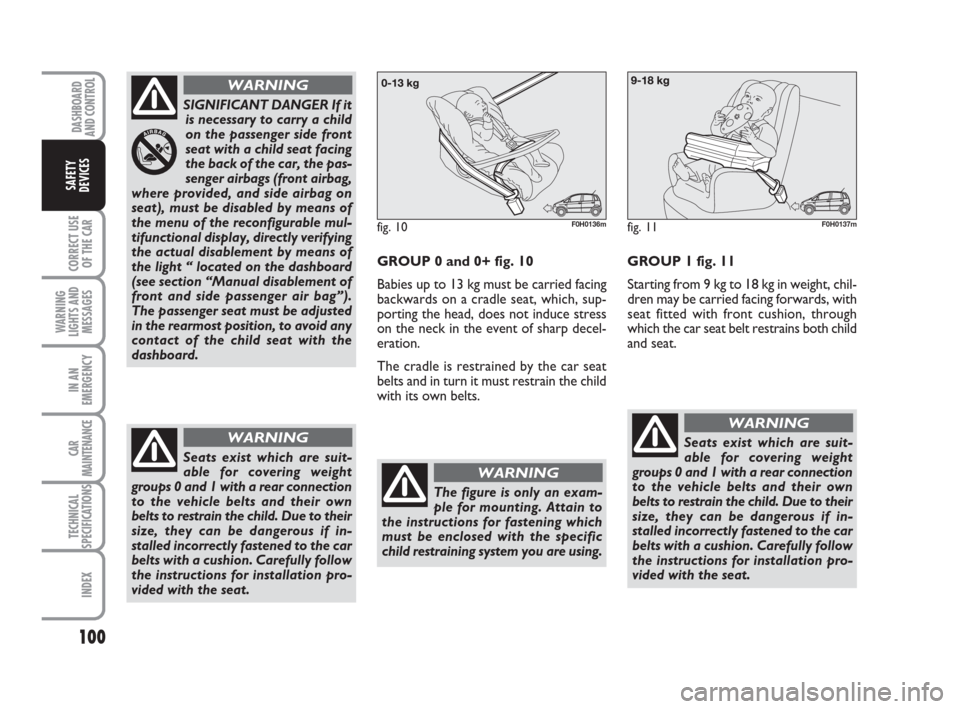
100
CORRECT USE
OF THE CAR
WARNING
LIGHTS AND
MESSAGES
IN AN
EMERGENCY
CAR
MAINTENANCE
TECHNICAL
SPECIFICATIONS
INDEX
DASHBOARD
AND CONTROL
SAFETY
DEVICES
SIGNIFICANT DANGER If it
is necessary to carry a child
on the passenger side front
seat with a child seat facing
the back of the car, the pas-
senger airbags (front airbag,
where provided, and side airbag on
seat), must be disabled by means of
the menu of the reconfigurable mul-
tifunctional display, directly verifying
the actual disablement by means of
the light “ located on the dashboard
(see section “Manual disablement of
front and side passenger air bag”).
The passenger seat must be adjusted
in the rearmost position, to avoid any
contact of the child seat with the
dashboard.
WARNING
GROUP 0 and 0+ fig. 10
Babies up to 13 kg must be carried facing
backwards on a cradle seat, which, sup-
porting the head, does not induce stress
on the neck in the event of sharp decel-
eration.
The cradle is restrained by the car seat
belts and in turn it must restrain the child
with its own belts.
fig. 10F0H0136m
The figure is only an exam-
ple for mounting. Attain to
the instructions for fastening which
must be enclosed with the specific
child restraining system you are using.
WARNING
Seats exist which are suit-
able for covering weight
groups 0 and 1 with a rear connection
to the vehicle belts and their own
belts to restrain the child. Due to their
size, they can be dangerous if in-
stalled incorrectly fastened to the car
belts with a cushion. Carefully follow
the instructions for installation pro-
vided with the seat.
WARNING
fig. 11F0H0137m
GROUP 1 fig. 11
Starting from 9 kg to 18 kg in weight, chil-
dren may be carried facing forwards, with
seat fitted with front cushion, through
which the car seat belt restrains both child
and seat.
Seats exist which are suit-
able for covering weight
groups 0 and 1 with a rear connection
to the vehicle belts and their own
belts to restrain the child. Due to their
size, they can be dangerous if in-
stalled incorrectly fastened to the car
belts with a cushion. Carefully follow
the instructions for installation pro-
vided with the seat.
WARNING
093-110 idea GB 1 ed 10-07-2008 8:28 Pagina 100
Page 102 of 210
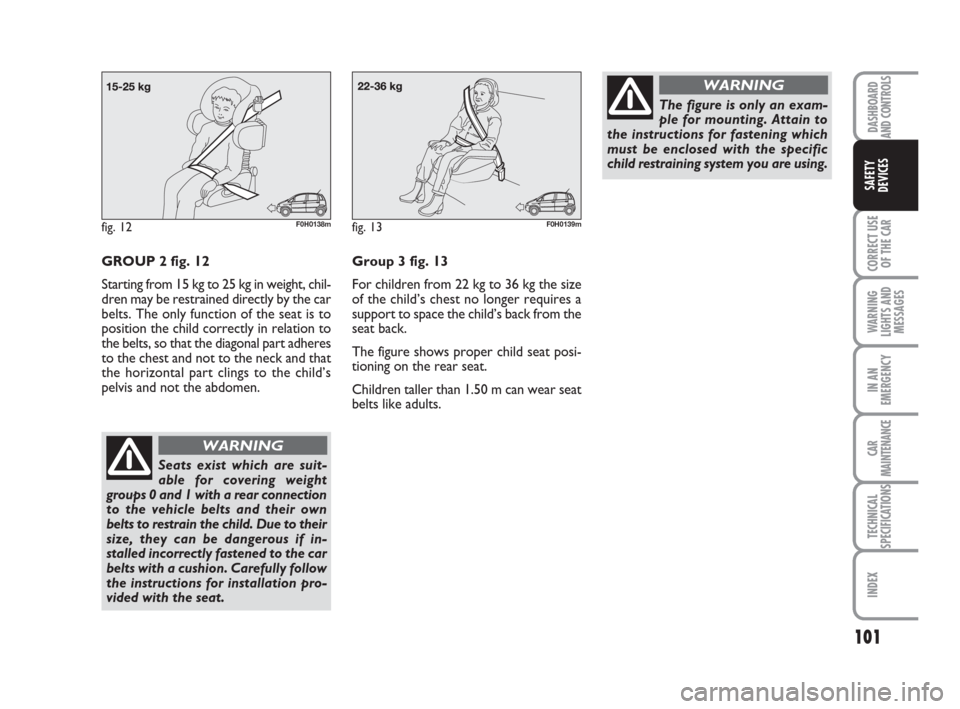
101
CORRECT USE
OF THE CAR
WARNING
LIGHTS AND
MESSAGES
IN AN
EMERGENCY
CAR
MAINTENANCE
TECHNICAL
SPECIFICATIONS
INDEX
DASHBOARD
AND CONTROLS
SAFETY
DEVICES
fig. 12F0H0138m
GROUP 2 fig. 12
Starting from 15 kg to 25 kg in weight, chil-
dren may be restrained directly by the car
belts. The only function of the seat is to
position the child correctly in relation to
the belts, so that the diagonal part adheres
to the chest and not to the neck and that
the horizontal part clings to the child’s
pelvis and not the abdomen.
Seats exist which are suit-
able for covering weight
groups 0 and 1 with a rear connection
to the vehicle belts and their own
belts to restrain the child. Due to their
size, they can be dangerous if in-
stalled incorrectly fastened to the car
belts with a cushion. Carefully follow
the instructions for installation pro-
vided with the seat.
WARNING
fig. 13F0H0139m
The figure is only an exam-
ple for mounting. Attain to
the instructions for fastening which
must be enclosed with the specific
child restraining system you are using.
WARNING
Group 3 fig. 13
For children from 22 kg to 36 kg the size
of the child’s chest no longer requires a
support to space the child’s back from the
seat back.
The figure shows proper child seat posi-
tioning on the rear seat.
Children taller than 1.50 m can wear seat
belts like adults.
093-110 idea GB 1 ed 10-07-2008 8:28 Pagina 101
Page 103 of 210

102
CORRECT USE
OF THE CAR
WARNING
LIGHTS AND
MESSAGES
IN AN
EMERGENCY
CAR
MAINTENANCE
TECHNICAL
SPECIFICATIONS
INDEX
DASHBOARD
AND CONTROL
SAFETY
DEVICES
PASSENGER SEAT COMPLIANCE WITH REGULATIONS ON CHILD’S SEAT USE
This vehicle complies with the new European Directive 2000/3/CE regulating child’s seat assembling on the different car seats ac-
cording to the following table:
SEAT
Group Range of weight Front passenger Rear passenger Central passenger
side rear
Group 0, 0+ until 13 kg U U *
Group 1 9-18 kg U U *
Group 2 15-25 kg U U *
Group 1 22-36 kg U U *
Key:
U = suitable for child restraint systems of the “Universal” category, according to European Standard ECE-R44 for the specified “Groups”.
* Never mount child restraint systems on the rear central seat.
093-110 idea GB 1 ed 10-07-2008 8:28 Pagina 102
Page 104 of 210
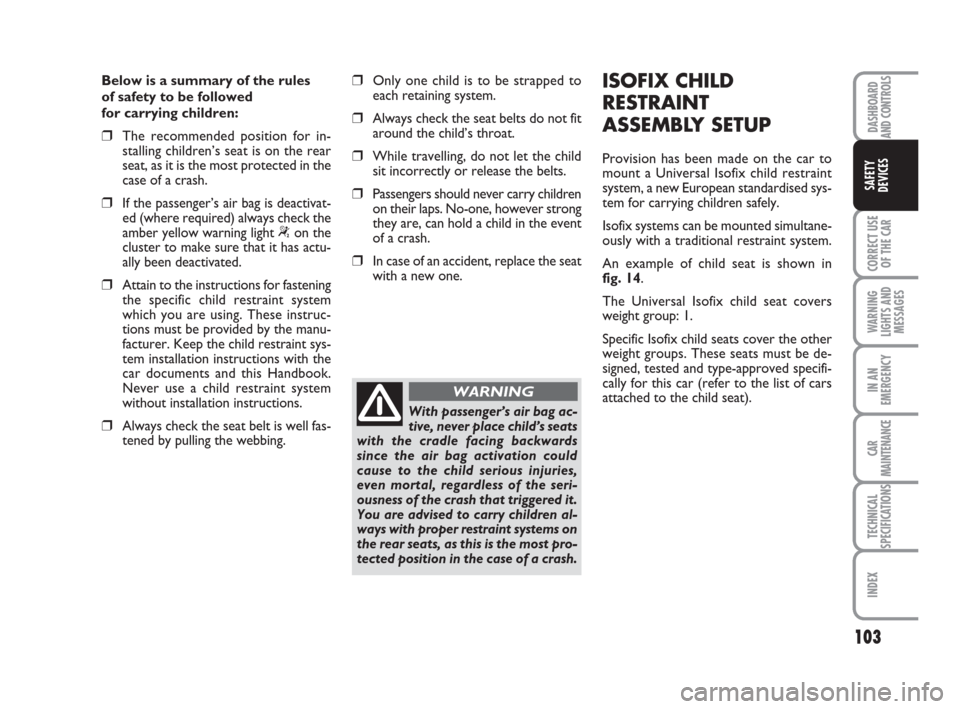
103
CORRECT USE
OF THE CAR
WARNING
LIGHTS AND
MESSAGES
IN AN
EMERGENCY
CAR
MAINTENANCE
TECHNICAL
SPECIFICATIONS
INDEX
DASHBOARD
AND CONTROLS
SAFETY
DEVICES
Below is a summary of the rules
of safety to be followed
for carrying children:
❒The recommended position for in-
stalling children’s seat is on the rear
seat, as it is the most protected in the
case of a crash.
❒If the passenger’s air bag is deactivat-
ed (where required) always check the
amber yellow warning light “on the
cluster to make sure that it has actu-
ally been deactivated.
❒Attain to the instructions for fastening
the specific child restraint system
which you are using. These instruc-
tions must be provided by the manu-
facturer. Keep the child restraint sys-
tem installation instructions with the
car documents and this Handbook.
Never use a child restraint system
without installation instructions.
❒Always check the seat belt is well fas-
tened by pulling the webbing.
❒Only one child is to be strapped to
each retaining system.
❒Always check the seat belts do not fit
around the child’s throat.
❒While travelling, do not let the child
sit incorrectly or release the belts.
❒Passengers should never carry children
on their laps. No-one, however strong
they are, can hold a child in the event
of a crash.
❒In case of an accident, replace the seat
with a new one.
With passenger’s air bag ac-
tive, never place child’s seats
with the cradle facing backwards
since the air bag activation could
cause to the child serious injuries,
even mortal, regardless of the seri-
ousness of the crash that triggered it.
You are advised to carry children al-
ways with proper restraint systems on
the rear seats, as this is the most pro-
tected position in the case of a crash.
WARNING
ISOFIX CHILD
RESTRAINT
ASSEMBLY SETUP
Provision has been made on the car to
mount a Universal Isofix child restraint
system, a new European standardised sys-
tem for carrying children safely.
Isofix systems can be mounted simultane-
ously with a traditional restraint system.
An example of child seat is shown in
fig. 14.
The Universal Isofix child seat covers
weight group: 1.
Specific Isofix child seats cover the other
weight groups. These seats must be de-
signed, tested and type-approved specifi-
cally for this car (refer to the list of cars
attached to the child seat).
093-110 idea GB 1 ed 10-07-2008 8:28 Pagina 103
Page 106 of 210
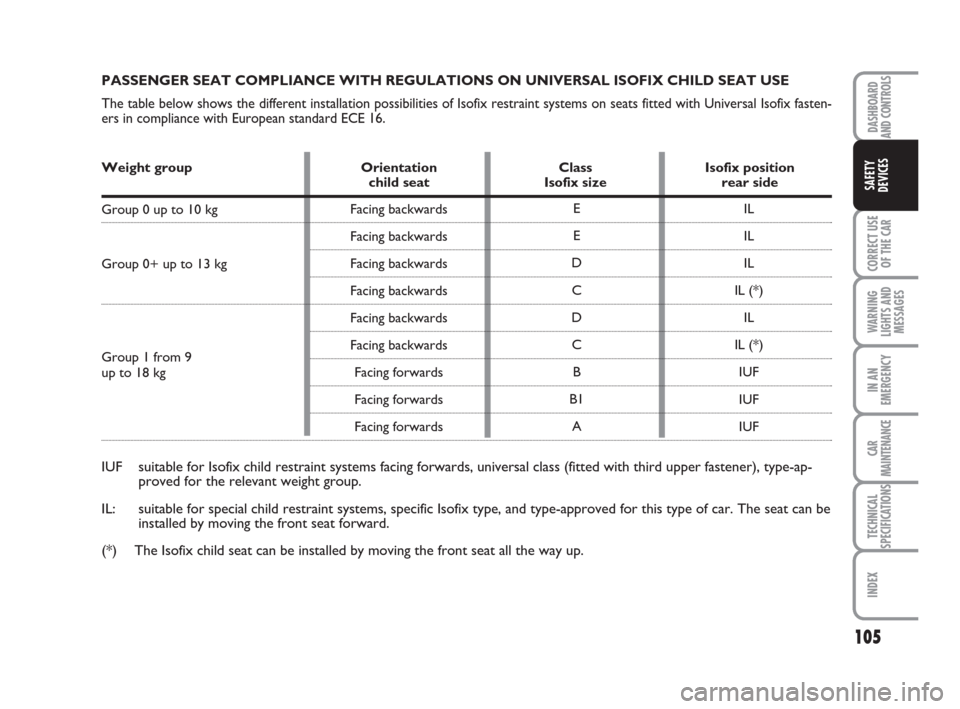
105
CORRECT USE
OF THE CAR
WARNING
LIGHTS AND
MESSAGES
IN AN
EMERGENCY
CAR
MAINTENANCE
TECHNICAL
SPECIFICATIONS
INDEX
DASHBOARD
AND CONTROLS
SAFETY
DEVICES
PASSENGER SEAT COMPLIANCE WITH REGULATIONS ON UNIVERSAL ISOFIX CHILD SEAT USE
The table below shows the different installation possibilities of Isofix restraint systems on seats fitted with Universal Isofix fasten-
ers in compliance with European standard ECE 16.
Weight group Orientation Class Isofix positionchild seat Isofix size rear side
Group 0 up to 10 kg
Group 0+ up to 13 kg
Group 1 from 9
up to 18 kg
Facing backwards
Facing backwards
Facing backwards
Facing backwards
Facing backwards
Facing backwards
Facing forwards
Facing forwards
Facing forwards E
E
D
C
D
C
B
B1
AIL
IL
IL
IL (*)
IL
IL (*)
IUF
IUF
IUF
IUF suitable for Isofix child restraint systems facing forwards, universal class (fitted with third upper fastener), type-ap-
proved for the relevant weight group.
IL: suitable for special child restraint systems, specific Isofix type, and type-approved for this type of car. The seat can be
installed by moving the front seat forward.
(*) The Isofix child seat can be installed by moving the front seat all the way up.
093-110 idea GB 1 ed 10-07-2008 8:28 Pagina 105
Page 117 of 210
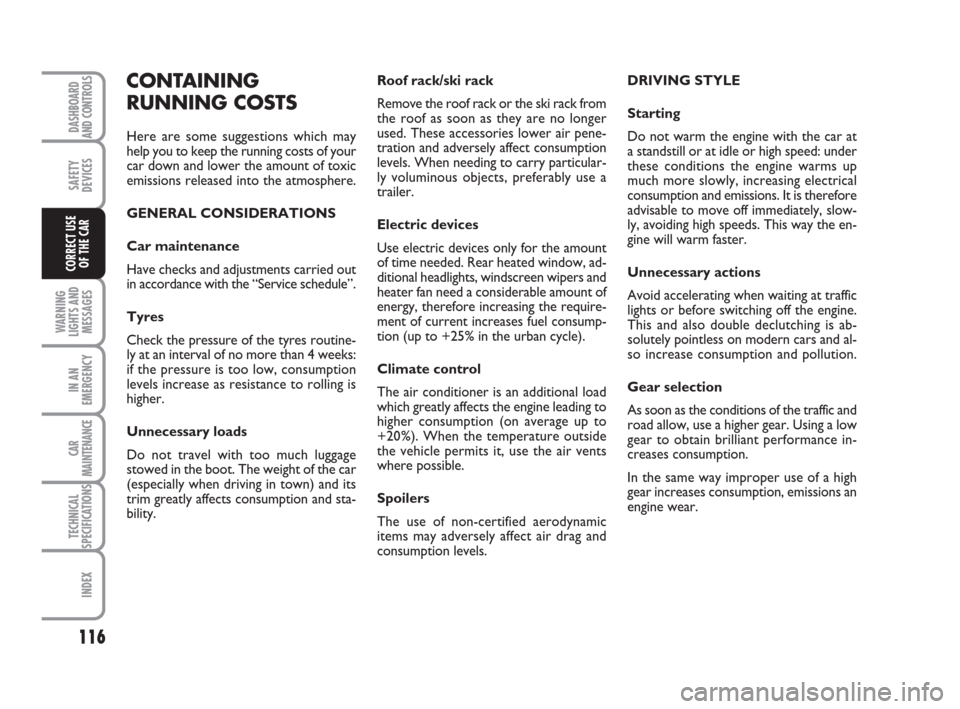
116
WARNING
LIGHTS AND
MESSAGES
IN AN
EMERGENCY
CAR
MAINTENANCE
TECHNICAL
SPECIFICATIONS
INDEX
DASHBOARD
AND CONTROLS
SAFETY
DEVICES
CORRECT USE
OF THE CAR
CONTAINING
RUNNING COSTS
Here are some suggestions which may
help you to keep the running costs of your
car down and lower the amount of toxic
emissions released into the atmosphere.
GENERAL CONSIDERATIONS
Car maintenance
Have checks and adjustments carried out
in accordance with the “Service schedule”.
Tyres
Check the pressure of the tyres routine-
ly at an interval of no more than 4 weeks:
if the pressure is too low, consumption
levels increase as resistance to rolling is
higher.
Unnecessary loads
Do not travel with too much luggage
stowed in the boot. The weight of the car
(especially when driving in town) and its
trim greatly affects consumption and sta-
bility.Roof rack/ski rack
Remove the roof rack or the ski rack from
the roof as soon as they are no longer
used. These accessories lower air pene-
tration and adversely affect consumption
levels. When needing to carry particular-
ly voluminous objects, preferably use a
trailer.
Electric devices
Use electric devices only for the amount
of time needed. Rear heated window, ad-
ditional headlights, windscreen wipers and
heater fan need a considerable amount of
energy, therefore increasing the require-
ment of current increases fuel consump-
tion (up to +25% in the urban cycle).
Climate control
The air conditioner is an additional load
which greatly affects the engine leading to
higher consumption (on average up to
+20%). When the temperature outside
the vehicle permits it, use the air vents
where possible.
Spoilers
The use of non-certified aerodynamic
items may adversely affect air drag and
consumption levels.DRIVING STYLE
Starting
Do not warm the engine with the car at
a standstill or at idle or high speed: under
these conditions the engine warms up
much more slowly, increasing electrical
consumption and emissions. It is therefore
advisable to move off immediately, slow-
ly, avoiding high speeds. This way the en-
gine will warm faster.
Unnecessary actions
Avoid accelerating when waiting at traffic
lights or before switching off the engine.
This and also double declutching is ab-
solutely pointless on modern cars and al-
so increase consumption and pollution.
Gear selection
As soon as the conditions of the traffic and
road allow, use a higher gear. Using a low
gear to obtain brilliant performance in-
creases consumption.
In the same way improper use of a high
gear increases consumption, emissions an
engine wear.
111-122 idea GB 1 ed 10-07-2008 8:29 Pagina 116
Page 118 of 210
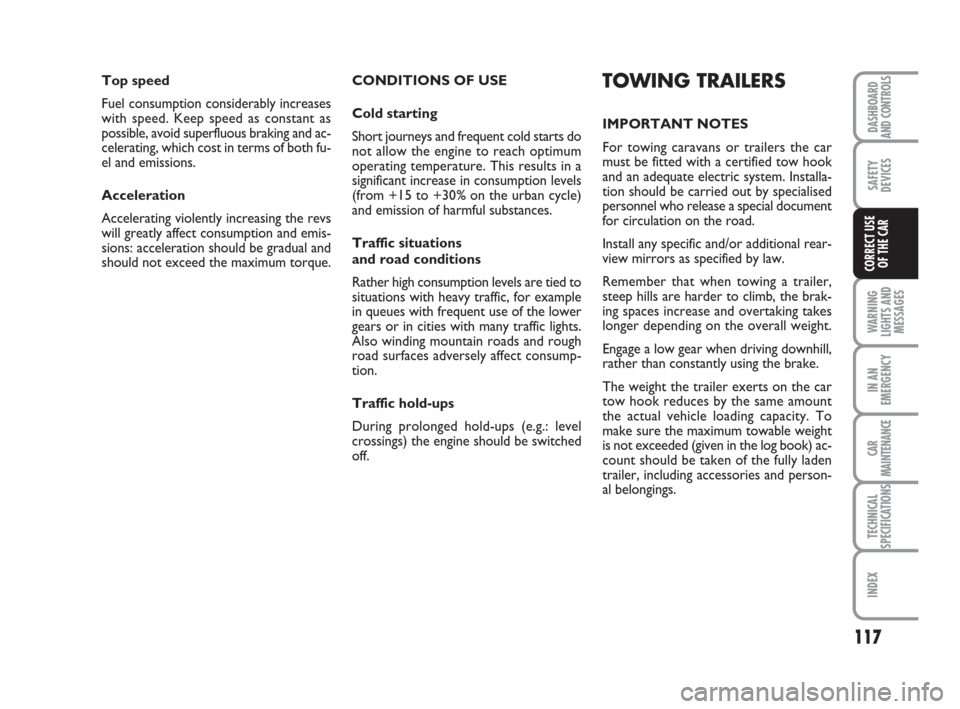
117
WARNING
LIGHTS AND
MESSAGES
IN AN
EMERGENCY
CAR
MAINTENANCE
TECHNICAL
SPECIFICATIONS
INDEX
DASHBOARD
AND CONTROLS
SAFETY
DEVICES
CORRECT USE
OF THE CAR
Top speed
Fuel consumption considerably increases
with speed. Keep speed as constant as
possible, avoid superfluous braking and ac-
celerating, which cost in terms of both fu-
el and emissions.
Acceleration
Accelerating violently increasing the revs
will greatly affect consumption and emis-
sions: acceleration should be gradual and
should not exceed the maximum torque.CONDITIONS OF USE
Cold starting
Short journeys and frequent cold starts do
not allow the engine to reach optimum
operating temperature. This results in a
significant increase in consumption levels
(from +15 to +30% on the urban cycle)
and emission of harmful substances.
Traffic situations
and road conditions
Rather high consumption levels are tied to
situations with heavy traffic, for example
in queues with frequent use of the lower
gears or in cities with many traffic lights.
Also winding mountain roads and rough
road surfaces adversely affect consump-
tion.
Traffic hold-ups
During prolonged hold-ups (e.g.: level
crossings) the engine should be switched
off.TOWING TRAILERS
IMPORTANT NOTES
For towing caravans or trailers the car
must be fitted with a certified tow hook
and an adequate electric system. Installa-
tion should be carried out by specialised
personnel who release a special document
for circulation on the road.
Install any specific and/or additional rear-
view mirrors as specified by law.
Remember that when towing a trailer,
steep hills are harder to climb, the brak-
ing spaces increase and overtaking takes
longer depending on the overall weight.
Engage a low gear when driving downhill,
rather than constantly using the brake.
The weight the trailer exerts on the car
tow hook reduces by the same amount
the actual vehicle loading capacity. To
make sure the maximum towable weight
is not exceeded (given in the log book) ac-
count should be taken of the fully laden
trailer, including accessories and person-
al belongings.
111-122 idea GB 1 ed 10-07-2008 8:29 Pagina 117